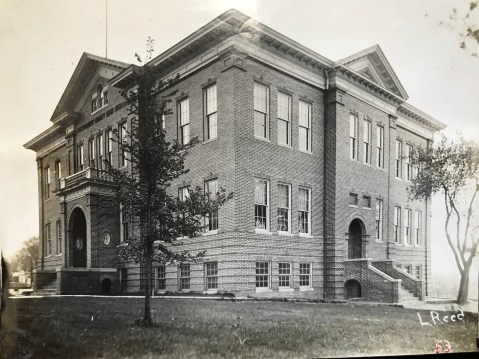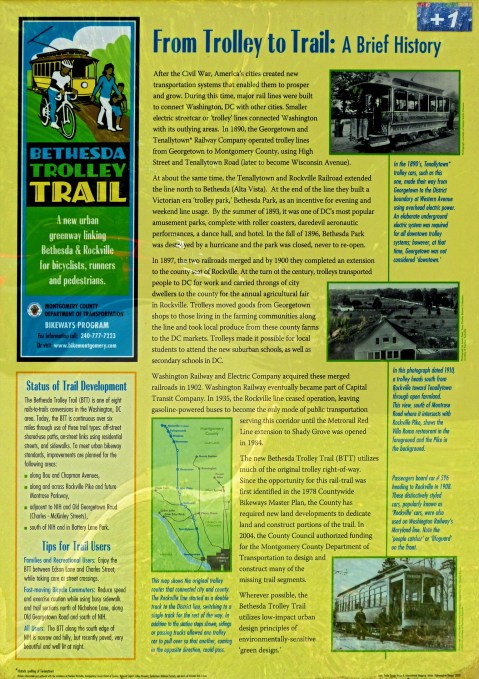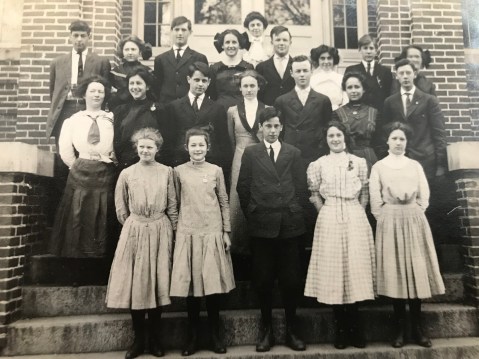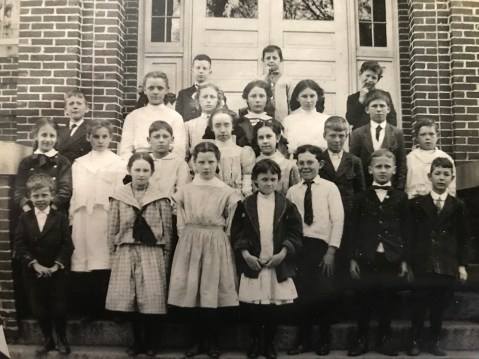Then & Now: Tenallytown & Rockville Pike Trolley Line
The latest installment in my Then & Now series takes us to south of Montrose Road where the Tenallytown and Rockville Pike trolley line intersects with Rockville Pike. The black & white photo was taken by Lewis Reed in 1910. The corresponding color photo is a Google Maps image, more than 100 years later. Matching the photos was a bit difficult as the location has changed so much, but you get the idea.
The Tennallytown and Rockville Railroad, which opened in 1890, was an extension of the Georgetown & Tenallytown Railway. The street car line was extended to Rockville in 1900 terminating at the fairgrounds. During the fair each fall, traffic was so heavy that two-car trains were run to accommodate the crowds. Later a further extension was made through Rockville on Montgomery Avenue to the Chestnut Lodge Sanitarium on the far side of town. In 1935, the Rockville trolley line ceased operation, leaving gasoline-powered buses as the only mode of public transportation serving this corridor until the Metrorail Red Line opened in 1984.
THEN: Tenallytown and Rockville Pike Trolley Line, 1910
In this photograph dated 1910, a trolley heads south from Rockville toward Tenallytown through open farmland. The view appears to be looking north and shows the area south of where Montrose Road intersects with Rockville Pike. The Pike is the white strip running diagonally behind the trolley car. The elevated vantage point, possibly from an adjacent rooftop or the roof of a barn, affords an excellent view of the rural countryside.

A trolley heads south from Rockville toward Tenallytown through open farmland. This view appears to be looking north and shows the area south of where Montrose Road intersects with Rockville Pike. The Pike is the white strip running diagonally behind the trolley car. Photo by Lewis Reed, 1910
NOW: The Bethesda Trolley Trail
Today, the six-mile Bethesda Trolley Trail connects Bethesda and Rockville for bicyclists, runners and pedestrians, following the route of the Tenallytown and Rockville Railroad, the former trolley line.

Woodglen Drive follows the old Bethesda Trolley Trail route today. The junction now is far from the tranquil road it once was. Google Maps image.
If there’s an historic wayside marker on the side of the road in Montgomery County, chances are, one of Lewis Reed’s images is on it. From Trolley to Trail Marker in Bethesda is one of many markers in Montgomery County that feature images from Lewis Reed’s collection of photographs.
From Trolley to Trail Marker in Bethesda
Location: Marker is in Bethesda, Maryland and can be reached from Norfolk Avenue near Rugby Avenue.
Duplicate: Another nearly identical marker is located at the exit ramp from westbound Montrose Parkway to northbound Rockville Pike (MD 355).
Fill’er up! Texaco Tanker Truck
The 1917 photo below is the Reed Brothers original Rockville Garage located at the intersection of Veirs Mill Road and Rockville Pike. To the right is a Texaco Gasoline Filling Station sign. One very tall Texaco branded fuel pump can be seen in this photo along with two Texaco Petroleum refueling trucks. The gas pump globe on the top advertises the gas company name and logo. Parked in front is a line-up of some very early Dodge Brothers Motor Vehicles.
Note the unpaved dirt road on Rockville Pike and trolley tracks running past the dealership. From 1900-1935, the trolley cars went past Reed Brothers Dodge as they traveled up Rockville Pike. Major stops along the line included Georgetown, Alta Vista, Bethesda, Montrose, Halpine, the Fairgrounds, Courthouse Square, and Chestnut Lodge.

1917 Original Rockville Garage with 2 story addition. Note the Texaco Filling Station signage and the Texaco Petroleum fuel truck refilling the single pump in front. Photo by Lewis Reed
At some point between prior to 1920, Reed Brothers Dodge changed over from selling Texaco and became a Gulf Gasoline dealer. Reed Brothers had the first Gulf gas station in the still-rural Washington D.C. area. (click on images to enlarge)
A Texaco Petroleum Truck sits in front of Rockville Garage after delivering its load of fuel. On the side of the tanker is a hinged wooden box carrying 2-drums of a Texaco product. The delivery driver seems to be wearing his best suit on this job, something that you don’t see these days at all.
In addition to Texaco gasoline, Rockville Garage also carried a full line of Texaco lubricants, Fisk tires, Willard batteries and many other well known brands of merchandise.
The most essential vehicle of the early 20th century had to have been the tanker truck. In the pioneering period of tanker trucks, 1910 to 1920, the Texas Company was among many that were fitted with tanks to carry refined products such as gasoline, kerosene and fuel oil.
Sept 17, 1908: Testing the Wright Military Flyer at Fort Myer, VA
On this day in September 17,1908, the first military airplane in the world, built by the Wright brothers for the Army Signal Corps, made its first flight at Fort Myer, Virginia. Less than a thousand people witnessed the first flight at Fort Myer, because the general public was still doubtful that powered flight had been achieved. But Lewis Reed was there… and to commemorate that milestone, I have posted six original snippets of history that Lewis Reed captured through the lens of his camera that day.

Soldiers at Fort Myer prepare to pull the Wright Military Flyer out of its temporary hangar. Photo by Lewis Reed
Five years after the first successful flight at Kitty Hawk, Orville Wright and Thomas E. Selfridge test flew the Wright Flyer in a demonstration for the U.S. Army at Fort Myer, VA. The Army was considering contracting Wright’s aircraft to use as a military airplane, but, in order to win the contract, he needed to demonstrate the plane’s ability to carry a passenger. Twenty-six-year-old Lt Thomas E. Selfridge volunteered to be a passenger that day. Orville Wright succeeded in keeping the Wright Flyer aloft for one minute and 11 seconds. After more than four minutes in the air, the airplane crashed to the ground from a height of about seventy-five feet after a propeller blade broke and the machine went out of control. Orville Wright was severely cut and bruised and his passenger, Lt. Thomas Selfridge, became the first powered-aviation fatality.

Another early aircraft from 1909 was the Bleriot XI monoplane. In the background a Rex Smith Aeroplane Company School is advertised on the side of a building. Photo by Lewis Reed
A Rex Smith Aeroplane Company School can be seen on the side of the building in the background. The founder, Rex Smith, was an inventor and a patent attorney. The Rex Smith Biplane was used in the successful April 3, 1911 U.S. Army Signal Corps experiments in wireless communications. The Signal Corps did not buy any Smith Biplanes, they did however use them from time to time to train pilots to fly the Curtiss aircraft at the same field.
The Wrights would prove their machine’s qualifications at Fort Myer. They met or exceeded all of the Army’s specifications, including flying at 40 miles per hour, carrying a combined passenger weight of 350 pounds, maneuvering in any direction in the air, landing without damage, and flying for at least an hour non-stop, which was a world record at the time.
Today, the Wright brothers are legends, with their accomplishments being the storybook example of American perseverance and ingenuity.
Rare Photos of the Wright Brothers at Fort Myer
On this day in September 17, 1908, Orville Wright and Lt. Thomas E. Selfridge test flew the Wright Flyer in a demonstration for the U.S. Army at Fort Myer, Virginia. Less than a thousand people witnessed the first flight at Fort Myer, because the general public was still doubtful that powered flight had been achieved. But Lewis Reed was there… and to commemorate that milestone, I have posted six original snippets of history that Lewis Reed captured through the lens of his camera that day.

Soldiers at Fort Myer prepare to pull the Wright Military Flyer out of its temporary hangar. Photo by Lewis Reed

Another early aircraft from 1909 was the Bleriot XI monoplane. In the background a Rex Smith Aeroplane Company School is advertised on the side of a building. Photo by Lewis Reed
A Rex Smith Aeroplane Company School can be seen on the side of the building in the background. The founder, Rex Smith, was an inventor and a patent attorney. The Rex Smith Biplane was used in the successful April 3, 1911 U.S. Army Signal Corps experiments in wireless communications. The Signal Corps did not buy any Smith Biplanes, they did however use them from time to time to train pilots to fly the Curtiss aircraft at the same field.
The Wrights would prove their machine’s qualifications at Fort Myer. They met or exceeded all of the Army’s specifications, including flying at 40 miles per hour, carrying a combined passenger weight of 350 pounds, maneuvering in any direction in the air, landing without damage, and flying for at least an hour non-stop, which was a world record at the time.
Today, the Wright brothers are legends, with their accomplishments being the storybook example of American perseverance and ingenuity.
Montgomery County High School 100 Years Ago

Originally known as Montgomery County High School, later as Rockville High School and Richard Montgomery High School. Located at the corner of Monroe Street and East Montgomery Avenue. Photo by Lewis Reed, circa 1906.
High school picture day is a tradition that dates back to the beginning of the 20th century. In honor of this year’s commencement, here is a look back at a collection of group photos of school children from Montgomery County High School that were taken by Lewis Reed in 1910. Most of the photos are labeled with only the year, so if you have corrections to the names or can identify other individuals, please contact me or leave a comment below. Several students have been identified by the Montgomery County Historical Society, which I have included.
A bit of history: Located in the City of Rockville, Richard Montgomery High School is the oldest public high school in Montgomery County. An allocation in 1892 by the then Board of School Commissioners of a $300 addition to the existing elementary school in Rockville brought to fruition the then named “Rockville High School” that served students from grades one to eleven. The first class of twelve seniors graduated in 1897. In 1904, the Board of Education purchased land at the corner of Montgomery Avenue and Monroe Street for the construction of a new school building, to be renamed “Montgomery County High School” at Rockville. Students came to the school by train, trolley, and later by school bus from all corners of the county. In 1935, when the new “Rockville Colored High School” building opened in Lincoln Park, the Board of Education officially renamed the old Rockville High School, “Richard Montgomery High School.”
Step back in time into a much simpler past and get a look at class photos of Montgomery County High School students from over a century ago. As always, click the photos to get a better look. Some of the expressions on these students faces are priceless!
Back row: Edward Story, Lena Ricketts, Tom Young, Louise Larcombe, Miss Ford, Fred Hays, Lucius Lamar, name unknown, name unknown.
Middle Row: name unknown, name unknown, Jesse Wathen, Jesse Higgins, name unknown, name unknown, Mary Hyatt, name unknown, name unknown.
Front Row: Maude England, Rebecca Lamar, (first name unknown) Garrett, Helen Pumphrey, (first name unknown) Lehman.
Back: Harry Beall, Katherine Hughes.
Middle: names unknown
Front: Edith Prettyman, (first name unknown) Darby
Rockville High School’s First Baseball Team
Interschool athletics in Montgomery County began with a meeting, duly noted in the Sentinel of February 18, 1910, of the principals of the high schools at Rockville, Gaithersburg, Kensington, and Sandy Spring to formulate plans for a baseball league. Within a month, the athletic association of Rockville High School was formed with Roger J. Whiteford, principal, as manager of the baseball team, Edward Story, teacher, as assistant manager, and Jesse Higgins student, as captain.
Front: Billy Beck, Tom Young, Edward Storey, Harry Beall, Roy Warfield.
Back: (first name unknown) Hicks, Lucius Lamar, name unknown, name unknown, Jesse Higgins, name unknown, name unknown, Fred Hays, Roger Whiteford
Holding pennant: Griffith Warfield
Times have changed dramatically since Montgomery County High School first opened its doors in 1892. One has only to think of the difference between chalk and slate and the new Promethean ActivBoards to begin to understand the new world in which we live.
Credit to: E. Guy Jewell, “Richard Montgomery High School.” The Montgomery County Story Vol. 24 (1981)



























Recent Comments